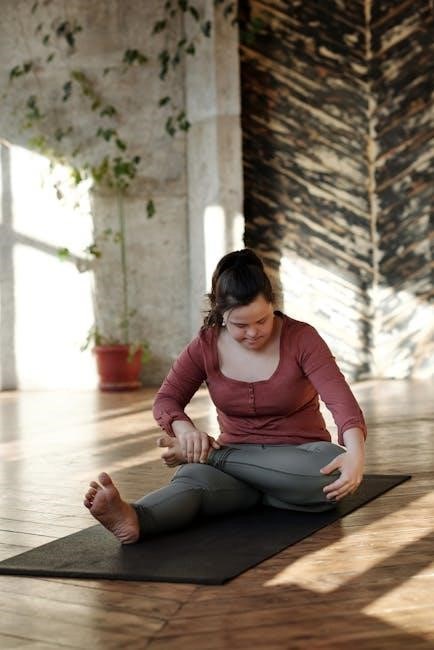IT Band Syndrome (ITBS) is a common overuse injury affecting cyclists and runners, caused by repetitive knee flexion. It leads to pain and swelling on the knee’s outside. Stretching and strengthening exercises are key to treatment and prevention, focusing on the hip and core muscles to reduce tension on the IT band.
1.1 Definition and Prevalence
IT Band Syndrome (ITBS) is an overuse injury caused by repetitive friction and inflammation of the iliotibial band near the knee. It’s highly prevalent among runners, cyclists, and athletes with repetitive knee movements. Studies show it affects up to 12% of long-distance runners annually. Early diagnosis and stretching exercises are crucial for effective management and prevention of this common condition.
1.2 Importance of Stretching in Treatment
Stretching is a cornerstone in treating IT Band Syndrome, as it reduces tension and inflammation in the iliotibial band. Regular stretches improve flexibility, alleviate pain, and restore range of motion. Targeted exercises, such as cross-leg stretches and side-lying stretches, are effective in managing symptoms and preventing recurrence, making them essential for both recovery and long-term management of ITBS.

Causes and Risk Factors of IT Band Syndrome
IT Band Syndrome often results from overuse, repetitive motion, and biomechanical issues. Activities like cycling and running, which involve repetitive knee flexion, increase the risk significantly.
2.1 Overuse and Repetitive Motion
Overuse and repetitive motion are primary contributors to IT Band Syndrome. Activities like cycling and running, involving repeated knee flexion, cause friction and irritation of the IT band. This consistent stress leads to inflammation and pain, especially in athletes who suddenly increase their training intensity or mileage without proper recovery.
2.2 Biomechanical Factors
Biomechanical factors, such as hip weakness and improper gait, significantly contribute to IT Band Syndrome. Weak hip muscles can lead to poor running form, increasing stress on the knee. Additionally, issues like overpronation or leg length discrepancies can alter movement patterns, causing repetitive friction on the IT band and leading to inflammation and pain during physical activity.
2.3 Weakness in Hip and Core Muscles
Weakness in the hip and core muscles is a major contributor to IT Band Syndrome. Poor hip strength disrupts running form, causing increased stress on the knee. Weak core muscles fail to stabilize the body, leading to improper movement patterns. Strengthening these areas is essential to reduce IT band tension and prevent recurrence of the injury during physical activities like cycling or running.

Symptoms of IT Band Syndrome
Common symptoms include pain on the outside of the knee, swelling, and tenderness. It often worsens with activity, impacting running, cycling, or repetitive knee movements, causing discomfort and limited mobility in athletes and active individuals.
3.1 Pain on the Outside of the Knee
Pain on the lateral side of the knee is a hallmark symptom of IT Band Syndrome. This discomfort often intensifies during activities like running or cycling, particularly when the knee bends. It may radiate along the IT band, from the hip to the knee, and can be sharp or dull, depending on the severity of inflammation or irritation present.
3.2 Swelling and Tenderness
Swelling and tenderness around the knee are common symptoms of IT Band Syndrome, often accompanying lateral knee pain. These symptoms arise from inflammation of the IT band and surrounding tissues. Tenderness may be palpable along the band’s edge, worsening with activity. Swelling can vary in severity, impacting mobility and comfort, especially during repetitive motions like running or cycling.
3.4 Impact on Athletic Performance
IT Band Syndrome significantly disrupts athletic performance, particularly in sports requiring repetitive knee movements. Pain and inflammation hinder running, cycling, and other activities, reducing speed, endurance, and overall efficiency. Athletes may experience frustration due to interrupted training and competition schedules, emphasizing the need for effective management strategies to restore functionality and resume peak performance levels.

Diagnosis of IT Band Syndrome
Diagnosis involves a physical exam, review of medical history, and imaging studies to confirm ITBS, ruling out other knee issues like meniscal tears or arthritis.
4.1 Physical Examination and History
A physical exam for ITBS involves palpation to identify tenderness along the IT band and assessment of knee range of motion. A thorough medical history focuses on activity levels, running or cycling habits, and repetitive motions. Pain during specific movements, like knee flexion, helps confirm the diagnosis.
4.2 Imaging Studies
Imaging studies like X-rays, MRIs, or ultrasounds are used to confirm ITBS diagnosis. X-rays rule out fractures, while MRIs detect inflammation or swelling in the IT band. Ultrasound provides real-time images of the tendon and surrounding tissues, aiding in precise evaluation of the condition and guiding treatment effectively.

Treatment Options for IT Band Syndrome
Treatment for IT Band Syndrome involves rest, ice, and physical therapy. Exercises, orthotics, and stretching are often recommended to alleviate symptoms and promote recovery effectively.
5.1 Rest and Ice Therapy
Rest and ice therapy are crucial initial steps in treating ITBS. Reducing activity minimizes further irritation, while icing the affected area helps reduce inflammation and alleviate pain. This approach is often combined with stretching exercises to promote healing and restore mobility without causing additional strain on the IT band.
5.2 Physical Therapy and Exercise
Physical therapy and targeted exercises play a vital role in treating ITBS by addressing weak hip and core muscles. Gentle stretching, strengthening exercises, and improving flexibility help reduce tension on the IT band. A structured program focusing on hip abductions, glute strengthening, and core stability can alleviate symptoms and prevent recurrence. Consistency and gradual progression are key to recovery.
5.3 Orthotics and Footwear Modifications
Orthotics and proper footwear can significantly aid in managing ITBS by correcting biomechanical issues such as overpronation. Custom orthotics and shoes with adequate arch support can reduce stress on the IT band, while cushioning helps absorb impact during activities. Modifying footwear to suit individual gait patterns can prevent further irritation and promote recovery.

Stretching Exercises for IT Band Syndrome
Stretching exercises are essential for IT Band Syndrome relief. Common stretches include the cross-leg stretch and leaning exercises to reduce tension and prevent further irritation on the IT band.
6.1 Standing IT Band Stretch
The standing IT band stretch targets the outer thigh and hip. Stand with feet shoulder-width apart, cross the affected leg behind the other, and lean away from the stretch. Hold for 30 seconds, feeling a gentle pull along the IT band. Repeat 2-3 times to improve flexibility and reduce tightness effectively.
6.2 Cross-Leg Stretch
The cross-leg stretch is a simple yet effective way to target the IT band. Sit with the affected leg crossed behind the unaffected leg, placing the ankle on the knee. Gently lean forward until a stretch is felt on the outer thigh. Hold for 30 seconds and repeat 2-3 times to relieve tightness and improve flexibility in the IT band and surrounding muscles.
6.3 Side-Lying IT Band Stretch
Lie on your side with the unaffected leg bent and the affected leg extended. Place the foot of the extended leg on the ground in front of the unaffected knee. Gently bend the knee of the affected leg, keeping the foot flexed, until a stretch is felt along the outer thigh. Hold for 30 seconds and repeat 2-3 times to alleviate IT band tightness.

Strengthening Exercises for IT Band Syndrome
Strengthening exercises for IT Band Syndrome focus on hip abduction, glute, and core muscles to improve stability and reduce tension on the IT band, aiding recovery and prevention.
7.1 Hip Abduction Exercises
Hip abduction exercises target the muscles responsible for hip stability, reducing IT band strain. Side-lying leg lifts and resistance band exercises are effective, enhancing strength and improving running or cycling performance by addressing hip weakness linked to ITBS. Consistent practice helps alleviate symptoms and prevents recurrence, making them a cornerstone of IT band syndrome management.
7.2 Glute Strengthening Exercises
Glute strengthening exercises are crucial for addressing ITBS, as weak glutes can lead to poor hip and knee alignment. Clamshells, bridges, and donkey kicks are effective for building strength. These exercises improve hip stability, reducing IT band tension during movement. Perform them with controlled form to avoid pain and enhance athletic performance, aiding in both recovery and prevention of future episodes.
7.3 Core Strengthening Exercises
Core strengthening exercises, such as planks, bird dogs, and side planks, are essential for improving stability and reducing IT band strain. A strong core enhances pelvic alignment and reduces hip and knee instability. Incorporate exercises like Russian twists and leg raises to target abdominal muscles. Consistent core work helps prevent ITBS by promoting better movement patterns and overall lower limb stability.

Foam Rolling for IT Band Syndrome
Foam rolling is a self-myofascial release technique that reduces IT band tension and promotes recovery. It helps alleviate tightness and improves circulation, aiding in symptom relief.
8.1 Techniques for Foam Rolling the IT Band
Foam rolling the IT band involves rolling from the hip to the knee, applying moderate pressure. Use slow, controlled movements to target tight areas. Focus on consistent, repetitive strokes to release tension. Avoid bouncing or applying excessive force, which can cause discomfort. Regular foam rolling helps reduce muscle tightness and improves circulation, complementing stretching and strengthening exercises for ITBS recovery and prevention.
8.2 Benefits of Foam Rolling in Recovery
Foam rolling enhances recovery by reducing muscle tension and improving circulation around the IT band. Regular use helps break down scar tissue, alleviates pain, and restores flexibility. It complements stretching and strengthening exercises, promoting faster recovery and reducing the risk of re-injury. Consistent foam rolling can improve overall muscle function and support long-term management of ITBS symptoms effectively.
Prevention of IT Band Syndrome
Preventing ITBS involves proper training techniques, gradual increases in activity, and regular stretching and strengthening routines. Addressing biomechanical issues and wearing suitable footwear can also reduce risk.
9.1 Proper Training and Running Techniques
Adopting proper training and running techniques is crucial for preventing ITBS. Avoid overstriding and ensure a midfoot strike to reduce stress on the IT band. Incorporating strength training for hip and core muscles can improve running form and lower injury risk. Regular gait analysis and biomechanical assessments can help identify and correct improper movements early. Consistency in technique reduces repetitive strain, promoting long-term injury prevention and enhanced performance.
9;2 Gradual Increase in Activity
Avoiding sudden increases in activity is essential to prevent ITBS. Gradually increasing mileage, intensity, or duration allows the IT band to adapt without excessive stress. Sudden changes can lead to inflammation and pain. Incorporating rest days and slowly progressing workouts helps maintain joint health and reduces the risk of overuse injuries, promoting long-term athletic performance and injury prevention.
9.3 Regular Stretching and Strengthening Routine
Consistent stretching and strengthening exercises target the IT band and surrounding muscles, reducing tightness and improving flexibility. Focusing on hip abductors, glutes, and core muscles helps distribute force evenly, preventing ITBS. A daily routine including cross-leg stretches and foam rolling can maintain muscle balance, enhance athletic performance, and significantly lower the risk of injury recurrence and chronic pain development over time.

When to Seek Professional Help
Consult a professional if pain persists, mobility is limited, or self-treatment shows no improvement. Expert guidance is crucial for advanced therapies and personalized recovery plans.
10.1 Persistent Pain and Limited Mobility
If pain persists despite self-care measures and significantly limits daily activities or athletic performance, consult an orthopedic specialist or physical therapist. Persistent discomfort may indicate underlying issues requiring professional intervention to prevent further injury and promote recovery; Ignoring these symptoms can lead to prolonged distress and hinder effective rehabilitation, making timely medical advice essential.
10.2 No Improvement with Self-Treatment
If self-treatment measures like stretching, icing, and rest fail to alleviate symptoms, it is crucial to seek professional guidance. A lack of improvement may signal the need for targeted therapies, such as physical therapy or advanced treatments, to address underlying issues and restore function. Persistent symptoms can lead to chronic pain or further injury, making professional intervention essential for effective recovery.
Case Studies and Success Stories
Athletes with ITBS have successfully returned to their sports through targeted stretches, strengthening exercises, and proper recovery techniques, showcasing the effectiveness of these methods in overcoming the condition.
11.1 Athletes Who Overcame ITBS
Many athletes, including cyclists and runners, have successfully overcome ITBS by incorporating targeted stretches and strengthening exercises into their routines. These individuals often report significant pain reduction and restored mobility, allowing them to return to their sports. Their recoveries highlight the effectiveness of consistent stretching, proper recovery techniques, and physical therapy in managing ITBS and preventing recurrence.
11.2 Effective Treatment Outcomes
Effective treatment for ITBS often results in significant pain reduction, restored mobility, and a return to normal activity levels. Combining IT band stretches, physical therapy, and foam rolling has shown to improve symptoms and prevent recurrence. Many individuals report full recovery within weeks, allowing them to resume sports and activities without discomfort, highlighting the importance of a comprehensive treatment approach.
IT Band Syndrome can be effectively managed with proper stretching, strengthening, and foam rolling. Proactive care and consistent routines are essential for long-term relief and prevention.
12.1 Summary of Key Points
IT Band Syndrome is an overuse injury common among runners and cyclists, caused by repetitive knee flexion. Key treatments include rest, ice, and physical therapy. Stretching and strengthening exercises, particularly for the hips and core, are crucial. Prevention involves proper training techniques and gradual activity increases. Regular foam rolling aids in recovery and reduces muscle tension.
12.2 Encouragement for Proactive Management
Proactive management of ITBS is key to recovery and prevention. Incorporate regular stretching, strengthening, and foam rolling into your routine. Prioritize proper training techniques and gradual activity increases to reduce risk. Consistently addressing hip and core weakness can significantly improve symptoms and overall athletic performance. Stay committed to these practices to ensure long-term relief and prevent future flare-ups.
